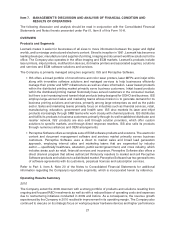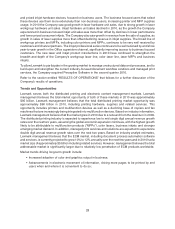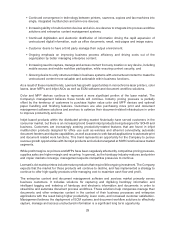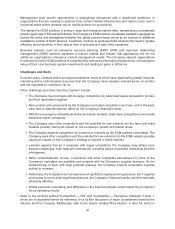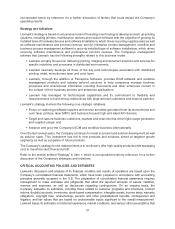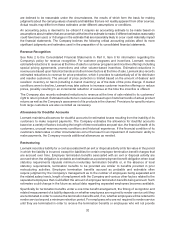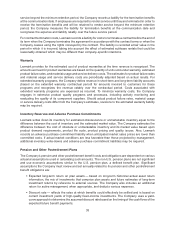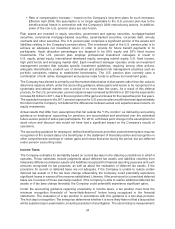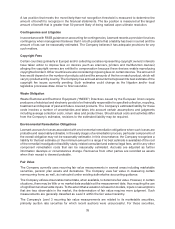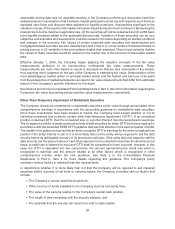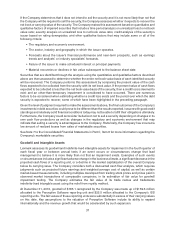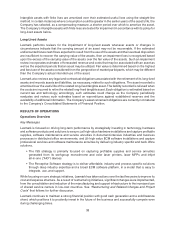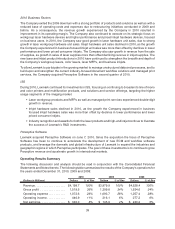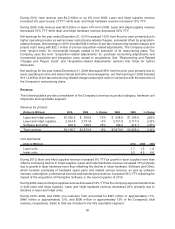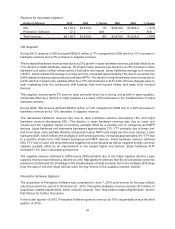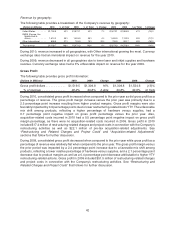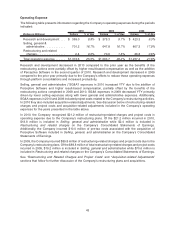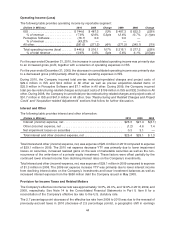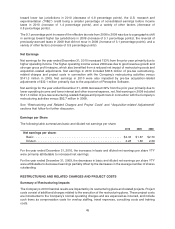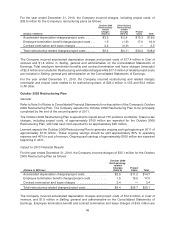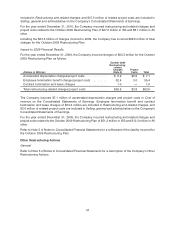Lexmark 2010 Annual Report Download - page 43
Download and view the complete annual report
Please find page 43 of the 2010 Lexmark annual report below. You can navigate through the pages in the report by either clicking on the pages listed below, or by using the keyword search tool below to find specific information within the annual report.If the Company determines that it does not intend to sell the security and it is not more likely than not that
the Company will be required to sell the security, the Company assesses whether it expects to recover the
net book or carrying value of the security. The Company makes this assessment based on quantitative and
qualitative factors of impaired securities that include a time period analysis on unrealized loss to net book
value ratio; severity analysis on unrealized loss to net book value ratio; credit analysis of the security’s
issuer based on rating downgrades; and other qualitative factors that may include some or all of the
following criteria:
• The regulatory and economic environment.
• The sector, industry and geography in which the issuer operates.
• Forecasts about the issuer’s financial performance and near-term prospects, such as earnings
trends and analysts’ or industry specialists’ forecasts.
• Failure of the issuer to make scheduled interest or principal payments.
• Material recoveries or declines in fair value subsequent to the balance sheet date.
Securities that are identified through the analysis using the quantitative and qualitative factors described
above are then assessed to determine whether the entire net book value basis of each identified security
will be recovered. The Company performs this assessment by comparing the present value of the cash
flows expected to be collected from the security with its net book value. If the present value of cash flows
expected to be collected is less than the net book value basis of the security, then a credit loss is deemed to
exist and an other-than-temporary impairment is considered to have occurred. There are numerous
factors to be considered when estimating whether a credit loss exists and the period over which the debt
security is expected to recover, some of which have been highlighted in the preceding paragraph.
Given the level of judgment required to make the assessments above, the final outcomes of the Company’s
investments in debt securities could prove to be different than the results reported. Issuers with good credit
standings and relatively solid financial conditions today may not be able to fulfill their obligations ultimately.
Furthermore, the Company could reconsider its decision not to sell a security depending on changes in its
own cash flow projections as well as changes in the regulatory and economic environment that may
indicate that selling a security is advantageous to the Company. Historically, the Company has incurred a
low amount of realized losses from sales of marketable securities.
See Note 7 to the Consolidated Financial Statements in Part II, Item 8 for more information regarding the
Company’s marketable securities.
Goodwill and Intangible Assets
Lexmark assesses its goodwill and indefinite-lived intangible assets for impairment in the fourth quarter of
each fiscal year or between annual tests if an event occurs or circumstances change that lead
management to believe it is more likely than not that an impairment exists. Examples of such events
or circumstances include a significant adverse change in the business climate, a significant decrease in the
projected cash flows of a reporting unit, or a decline in the market capitalization of the overall Company
below its carrying value. The Company considers both a discounted cash flow analysis, which requires
judgments such as projected future earnings and weighted average cost of capital, as well as certain
market-based measurements, including multiples developed from trading stock prices and prices paid in
observed market transactions of comparable companies, in its estimation of fair value for goodwill
impairment testing. The Company estimates the fair value of its trade names and trademarks
indefinite-lived intangible asset using the relief from royalty method.
At December 31, 2010, goodwill of $185.1 recognized by the Company was made up of $159.6 million
allocated to the Perceptive Software reporting unit and $25.5 million allocated to the Company’s ISS
reporting units. The fair values of these reporting units were substantially in excess of their carrying values
on this date. Key assumptions to the valuation of Perceptive Software include its ability to expand
internationally and the revenue growth that would be accelerated by such expansion.
37


